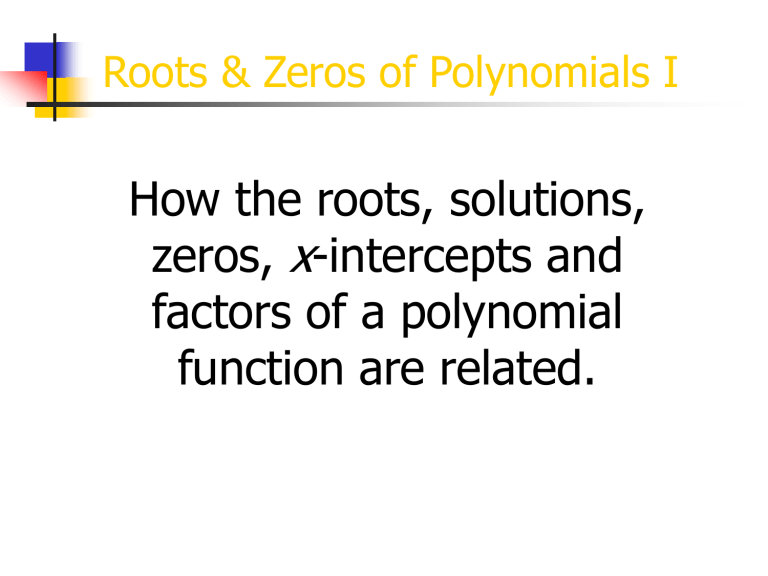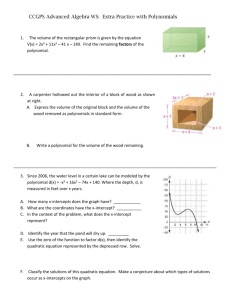Roots & Zeros of Polynomials

Roots & Zeros of Polynomials I
How the roots, solutions, zeros,
x
-intercepts and factors of a polynomial function are related.
Polynomials
A Polynomial Expression can be a monomial or a sum of monomials. The
Polynomial Expressions that we are discussing today are in terms of one variable.
In a Polynomial Equation , two polynomials are set equal to each other.
Factoring Polynomials
Terms are Factors of a Polynomial if, when they are multiplied, they equal that polynomial: x
2
2 x
15
( x
3)( x
5)
( x - 3) and ( x + 5) are Factors of the polynomial x
2
2 x
15
Since Factors are a Product...
…and the only way a product can equal zero is if one or more of the factors are zero…
…then the only way the polynomial can equal zero is if one or more of the factors are zero.
Solving a Polynomial Equation
Rearrange the terms to have zero on one side: x
2
2 x
15
x
2
2 x
15
0
Factor:
( x
5)( x
0
Set each factor equal to zero and solve:
( x
0 and ( x
0 x
5 x
3
The only way that x 2 +2 x - 15 can = 0 is if x = -5 or x = 3
Solutions/Roots a Polynomial
Setting the Factors of a Polynomial
Expression equal to zero gives the
Solutions to the polynomial expression equals zero.
Another name for the Solutions of a
Polynomial is the Roots of a
Polynomial !
Equation when the
Zeros of a Polynomial Function
A Polynomial Function is usually written in function notation or in terms of x and y .
f ( x ) x 2 2 x 15 or y x 2 2 x 15
The Zeros of a Polynomial Function are the solutions to the equation you get when you set the polynomial equal to zero.
Zeros of a Polynomial Function
The Zeros of a
Polynomial
Function
ARE the Solutions to the
Polynomial Equation
when the polynomial equals zero.
Graph of a Polynomial
Function
Here is the graph of our polynomial function: y x 2 2 x 15
The Zeros of the Polynomial are the values of x when the polynomial equals zero. In other words, the Zeros are the x -values where y equals zero .
x
-Intercepts of a Polynomial
The points where y = 0 are called the x -intercepts of the graph.
The x -intercepts for our graph are the points...
(-5, 0) and y x 2 2 x 15
(3, 0)
x -Intercepts of a Polynomial
When the Factors of a Polynomial
Expression are set equal to zero, we get the Solutions or Roots of the Polynomial
Equation .
The Solutions/Roots of the Polynomial
Equation are the x -coordinates for the x-Intercepts of the Polynomial Graph !
Factors, Roots, Zeros
For our Polynomial Function : y x 2 2 x 15
The Factors are: ( x + 5) & ( x - 3)
The Roots/Solutions are: x = -5 and 3
The Zeros are at: (-5, 0) and (3, 0)
Roots & Zeros of Polynomials II
Finding the Roots/Zeros of Polynomials:
• The Fundamental Theorem of Algebra
• Descartes’ Rule of Signs
• The Complex Conjugate Theorem
Fundamental Theorem Of Algebra
Every Polynomial Equation with a degree higher than zero has at least one root in the set of Complex Numbers .
COROLLARY:
A Polynomial Equation of the form P(x) = 0 of degree ‘n’ with complex coefficients has exactly ‘n’ Roots in the set of Complex
Numbers.
Real/Imaginary Roots
If a polynomial has ‘n’ complex roots will its graph have ‘n’ x-intercepts?
y x 3 4 x
In this example, the degree n = 3 , and if we factor the polynomial, the roots are x = -2, 0, 2. We can also see from the graph that there are 3 x -intercepts.
Real/Imaginary Roots
Just because a polynomial has ‘n’ complex roots doesn’t mean that they are all Real!
y x 3 2 x 2 x 4
In this example, however, the degree is still n = 3 , but there is only one Real x -intercept or root at x = -1, the other 2 roots must have imaginary components.
Descartes’ Rule of Signs
Arrange the terms of the polynomial P(x) in descending degree:
• The number of times the coefficients of the terms of P(x) change sign = the number of Positive Real
Roots (or less by any even number)
• The number of times the coefficients of the terms of P(-x) change sign = the number of Negative
Real Roots (or less by any even number)
In the examples that follow, use Descartes’ Rule of Signs to predict the number of + and - Real Roots!
Find Roots/Zeros of a
Polynomial
We can find the Roots or Zeros of a polynomial by setting the polynomial equal to 0 and factoring.
Some are easier to factor than others!
f ( x ) x 3 4 x
x ( x 2 4)
x ( x 2)( x 2)
The roots are: 0, -2, 2
Find Roots/Zeros of a
Polynomial
If we cannot factor the polynomial, but know one of the roots, we can divide that factor into the polynomial. The resulting polynomial has a lower degree and might be easier to factor or solve with the quadratic formula.
f ( x ) x 3 5 x 2 one root is x 5
2 x 10 x 5
x 3 x 3
(x - 5) is a factor
We can solve the resulting polynomial to get the other 2 roots:
5 x 2
5 x 2 x 2
2 x 10
2
2 x 10
2 x 10 x
2,
2
0
Complex Conjugates Theorem
Roots/Zeros that are not Real are Complex with an
Imaginary component. Complex roots with
Imaginary components always exist in Conjugate
Pairs .
If a + bi ( b ≠ 0) is a zero of a polynomial function, then its Conjugate, a - bi , is also a zero of the function.
Find Roots/Zeros of a
Polynomial
If the known root is imaginary , we can use the Complex
Conjugates Theorem.
Ex: Find all the roots of f ( x ) x 3 5 x 2 7 x 51
If one root is 4 - i .
Because of the Complex Conjugate Theorem, we know that another root must be 4 + i .
Can the third root also be imaginary?
Consider… Descartes: # of Pos. Real Roots = 2 or 0
Descartes: # of Neg. Real Roots = 1
Example (con’t)
Ex: Find all the roots of f ( x ) x 3 5 x 2 7 x 51
If one root is 4 - i .
If one root is 4 - i , then one factor is [x ( 4 - i)], and
Another root is 4 + i , & another factor is [x ( 4 + i)].
x
Multiply these factors:
i
x
4 i
x
2 x
4 i
x
4 i
4
x
2
4 x
xi
4 x
xi
16
i
2
x
2
8 x
x
2
8 x
17 i
4
i
Example (con’t)
Ex: Find all the roots of f ( x ) x 3 5 x 2 7 x 51
If one root is 4 - i .
If the product of the two non-real factors is x 2 8 x 17 then the third factor (that gives us the neg. real root) is the quotient of P(x) x 8 x 17 x 2 8 x 17
x 3 x 3
5 x 2
5 x 2 x 3
7 x 51
7 x 51
0
The third root is x = -3
Finding Roots/Zeros of
Polynomials
We use the Fundamental Thm. Of Algebra, Descartes’ Rule of Signs and the Complex Conjugate Thm. to predict the nature of the roots of a polynomial.
We use skills such as factoring, polynomial division and the quadratic formula to find the zeros/roots of polynomials.
In future lessons you will learn other rules and theorems to predict the values of roots so you can solve higher degree polynomials!






